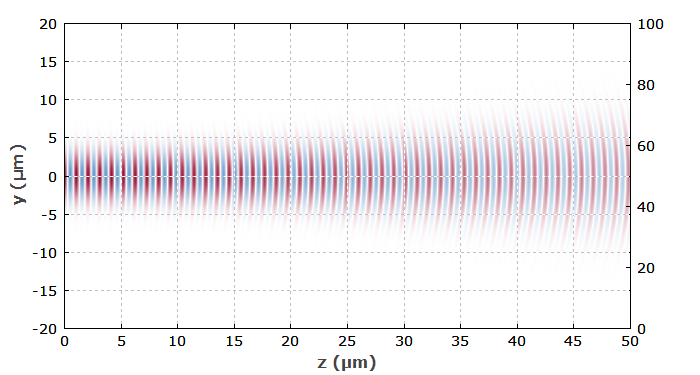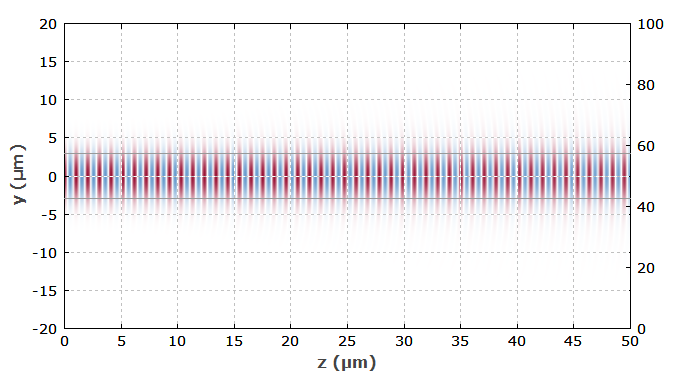Passive Fiber Optics
This is part 1 of a tutorial on passive fiber optics from Dr. Paschotta. The tutorial has the following parts:
1: Guiding light in a glass fiber, 2: Fiber modes, 3: Single-mode fibers, 4: Multimode fibers, 5: Fiber ends, 6: Fiber joints, 7: Propagation losses, 8: Fiber couplers and splitters, 9: Polarization issues, 10: Chromatic dispersion of fibers, 11: Nonlinearities of fibers, 12: Ultrashort pulses and signals in fibers, 13: Accessories and tools
Part 1: Guiding Light in a Glass Fiber
The basic function of any optical fiber is to guide light, i.e., to act as a dielectric waveguide: light injected into one end should stay guided in the fiber. In other words, it must be prevented from getting lost e.g. by reaching the outer surface and escaping there. We explain this here for glass fibers, but the operation principle of plastic optical fibers is the same.
In principle, the simplest solution for guiding light would be a homogeneous glass rod. (If it is thin enough, it can also be bent to some degree.) The outer surface can reflect light via total internal reflection. Due to the large refractive index contrast, this works for a considerable range of input beam angles, and in principle there don't need to be any power losses.

However, this simple solution has some crucial disadvantages:
- Due to the high index contrast, even tiny scratches of the glass on the outer surface could lead to substantial optical losses by scattering. Therefore, the outer surface would have to be made with high optical quality and well protected against damage and dirt. This problem can be mitigated only to some extent with some suitable buffer coating around the fiber; such coatings, not being highly homogeneous, can hardly provide very low optical losses.
- Even if the fiber were pretty thin (e.g., with a diameter of 0.1 mm), it would support a huge number of modes (see part 2), which is bad e.g. when preserving a high beam quality is important.
One can, however, modify the idea of a very clean coating: use another glass region, having a slightly smaller refractive index than the core glass, as a cladding:

That gives us several advantages:
- Glass can be much more clean and homogeneous than a plastic buffer coating. That already reduces the losses.
- Due to the reduced index contrast at the reflection points, small irregularities of the interface do not cause as serious optical losses as for a glass/air interface. Irregularities at the outer interface do not matter any more, as the light cannot “see” them.
- The guiding region – called the fiber core – can now be made much smaller than the total fiber, if this is wanted. One can adapt the core size e.g. to the size of some small light emitter.
- With a combination of small core size and weak index contrast one can even obtain single-mode guidance (see below).
Note, however, that smaller index contrasts imply a smaller acceptance angle: total internal reflection can only occur if the incidence angle is above the critical angle. The maximum angle of incidence at the input face of the fiber is then determined by the numerical aperture (NA):
The NA is the sine of the maximum angle of incidence at the input face. In the equation, n0 is the refractive index of the medium around the fiber, which is close to 1 in case of air.
Considering the Wave Nature of Light
The preceding considerations were based on a simple geometrical ray picture. Particularly in the domain of small cores and weak index contrasts, that simple picture does no more represent an accurate model for light propagation, as it ignores the wave nature of light. So let us now consider the wave nature.
First, we imagine at a Gaussian beam in a homogeneous medium (e.g., some glass). Even if such a beam has flat wavefronts initially, within one Rayleigh length it will start diverging significantly:

The divergence is intimately related to a curvature of the wavefronts. Apparently, the wavefronts on the beam axis progress faster in z direction than those at higher or lower positions. That observation can trigger an idea: couldn't we work against that bending of wavefronts by somewhat slowing down the light near the beam axis? That could be done by using an inhomogeneous structure, with a somewhat increased refractive index in the central region. Indeed, this works quite well if we simply increase the core index by 0.014 within a radius of 3 μm:

The numerical aperture is then 0.3. Nearly all light of the injected Gaussian beam is guided. An even lower index contrast would be sufficient for that purpose if we make the initial beam radius and the core region larger.
Note that the guiding of light works even if the fiber is not perfectly straight, but somewhat bent. If the bending is not too strong, bend losses (i.e., power losses induced by bending) are negligibly small.
Go to Part 2: Fiber Modes or back to the start page.
Questions and Comments from Users
Here you can submit questions and comments. As far as they get accepted by the author, they will appear above this paragraph together with the author’s answer. The author will decide on acceptance based on certain criteria. Essentially, the issue must be of sufficiently broad interest.
Please do not enter personal data here; we would otherwise delete it soon. (See also our privacy declaration.) If you wish to receive personal feedback or consultancy from the author, please contact him e.g. via e-mail.
By submitting the information, you give your consent to the potential publication of your inputs on our website according to our rules. (If you later retract your consent, we will delete those inputs.) As your inputs are first reviewed by the author, they may be published with some delay.



These sharing buttons are implemented in a privacy-friendly way!


